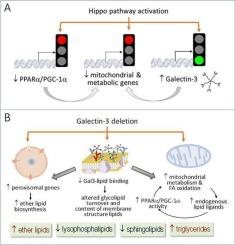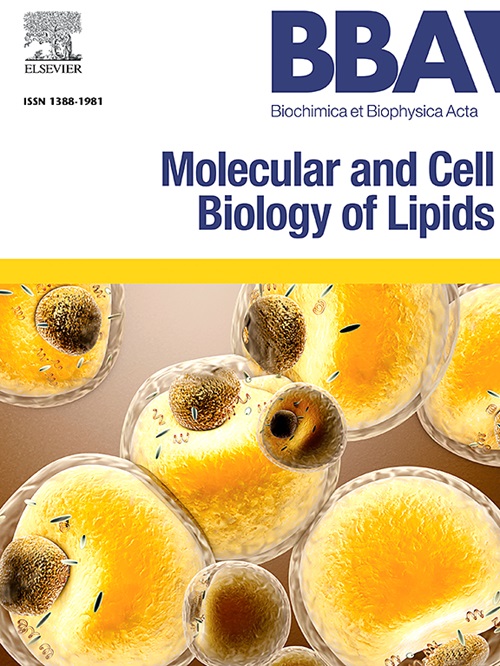Galectin-3 gene deletion alters lipid profile in healthy and cardiomyopathy mouse hearts
IF 3.3
2区 生物学
Q2 BIOCHEMISTRY & MOLECULAR BIOLOGY
Biochimica et biophysica acta. Molecular and cell biology of lipids
Pub Date : 2025-08-05
DOI:10.1016/j.bbalip.2025.159676
引用次数: 0
Abstract
Galectin-3 (Gal3) is known to interact with glycans of proteins and lipids. In cardiovascular disease, the elevated expression of Gal3 mediates inflammation, hypertrophy and fibrosis. We explored the effect of Gal3 on the cardiac lipid profile in healthy mice or in mice with dilated cardiomyopathy (DCM). Using lipidomics and gene-targeted mouse models, we studied the influence of Gal3 gene deletion on cardiac lipid profiles in the healthy mice or mice with DCM. Cardiac-restricted transgenic activation of Hippo pathway led to DCM phenotype and Gal3 upregulation. DCM mice were cross-bred with Gal3 gene knockout (KO) mice to obtain genotypes of non-transgenic (nTG), Gal3-KO, DCM and DCM/KO. Alterations in the lipid classes and species due to Gal3-KO were identified by lipidomics in hearts from mice of four genotypes. In the nTG background, Gal3-KO increased ether lipids and lysophospholipids, and induced diverse changes of sphingolipid subclasses. The DCM hearts exhibited profound lipidomic changes including increase in sphingolipids and reduction in ether lipids and triglycerides, which were partially reversed by Gal3 deletion. We demonstrated the nuclear and mitochondrial localization of Gal-3 in DCM hearts. Transcriptomics revealed that Gal3 deletion in the DCM background partially restored the suppressed expression of mitochondrial lipid metabolic genes. In conclusion, we report multiple alterations in the lipid classes and species in the heart by Gal3 deletion in the healthy mice and, more importantly mice with DCM background. Our findings suggest that Gal3 alters cardiac contents of lipids in the DCM model in part through suppression of mitochondrial metabolism.

半乳糖凝集素-3基因缺失改变健康和心肌病小鼠心脏的脂质谱
已知半乳糖凝集素-3 (Gal3)与蛋白质和脂质的聚糖相互作用。在心血管疾病中,Gal3的表达升高介导炎症、肥大和纤维化。我们探讨了Gal3对健康小鼠和扩张型心肌病(DCM)小鼠心脏脂质谱的影响。利用脂质组学和基因靶向小鼠模型,我们研究了Gal3基因缺失对健康小鼠和DCM小鼠心脏脂质谱的影响。心脏受限的Hippo通路转基因激活导致DCM表型和Gal3上调。将DCM小鼠与Gal3基因敲除(KO)小鼠杂交,获得非转基因(nTG)、Gal3-KO、DCM和DCM/KO基因型。在四种基因型小鼠的心脏中,脂质组学鉴定了Gal3-KO引起的脂质种类和种类的改变。在nTG背景下,Gal3-KO增加了醚脂和溶血磷脂,并引起鞘脂亚类的不同变化。DCM心脏表现出深刻的脂质组学变化,包括鞘脂增加、醚脂和甘油三酯减少,这些变化被Gal3缺失部分逆转。我们证实了DCM心脏中Gal-3的核和线粒体定位。转录组学显示,DCM背景下Gal3的缺失部分恢复了线粒体脂质代谢基因的抑制表达。总之,我们报告了健康小鼠,更重要的是具有DCM背景的小鼠,Gal3缺失导致心脏脂质种类和种类的多种改变。我们的研究结果表明,在DCM模型中,Gal3部分通过抑制线粒体代谢来改变心脏脂质含量。
本文章由计算机程序翻译,如有差异,请以英文原文为准。
求助全文
约1分钟内获得全文
求助全文
来源期刊
CiteScore
11.00
自引率
2.10%
发文量
109
审稿时长
53 days
期刊介绍:
BBA Molecular and Cell Biology of Lipids publishes papers on original research dealing with novel aspects of molecular genetics related to the lipidome, the biosynthesis of lipids, the role of lipids in cells and whole organisms, the regulation of lipid metabolism and function, and lipidomics in all organisms. Manuscripts should significantly advance the understanding of the molecular mechanisms underlying biological processes in which lipids are involved. Papers detailing novel methodology must report significant biochemical, molecular, or functional insight in the area of lipids.

 求助内容:
求助内容: 应助结果提醒方式:
应助结果提醒方式:


